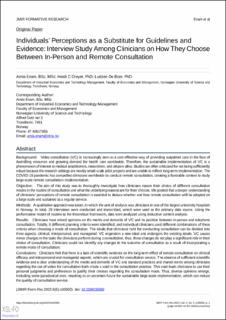| dc.description.abstract | Background:
Video consultation (VC) is increasingly seen as a cost-effective way of providing outpatient care in the face of dwindling resources and growing demand for health care worldwide. Therefore, the sustainable implementation of VC is a phenomenon of interest to medical practitioners, researchers, and citizens alike. Studies are often criticized for not being sufficiently robust because the research settings are mostly small-scale pilot projects and are unable to reflect long-term implementation. The COVID-19 pandemic has compelled clinicians worldwide to conduct remote consultation, creating a favorable context to study large-scale remote consultation implementation.
Objective:
The aim of this study was to thoroughly investigate how clinicians reason their choice of different consultation modes in the routine of consultation and what the underlying reasons are for their choices. We posited that a deeper understanding of clinicians’ perceptions of remote consultation is essential to deduce whether and how remote consultation will be adopted on a large scale and sustained as a regular service.
Methods:
A qualitative approach was taken, in which the unit of analysis was clinicians in one of the largest university hospitals in Norway. In total, 29 interviews were conducted and transcribed, which were used as the primary data source. Using the performative model of routine as the theoretical framework, data were analyzed using deductive content analysis.
Results:
Clinicians have mixed opinions on the merits and demerits of VC and its position between in-person and telephone consultation. Totally, 6 different planning criteria were identified, and individual clinicians used different combinations of these criteria when choosing a mode of consultation. The ideals that clinicians hold for conducting consultation can be divided into three aspects: clinical, interpersonal, and managerial. VC engenders a new ideal and endangers the existing ideals. VC causes minor changes in the tasks the clinicians perform during a consultation; thus, these changes do not play a significant role in their choice of consultation. Clinicians could not identify any changes in the outcome of consultation as a result of incorporating a remote mode of consultation.
Conclusions:
Clinicians feel that there is a lack of scientific evidence on the long-term effect of remote consultation on clinical efficacy and interpersonal and managerial aspects, which are crucial for consultation service. The absence of sufficient scientific evidence and a clear understanding of the merits and demerits of VC and standard practices and shared norms among clinicians regarding the use of video for consultation both create a void in the consultation practice. This void leads clinicians to use their personal judgments and preferences to justify their choices regarding the consultation mode. Thus, diverse opinions emerge, including some paradoxical ones, resulting in an uncertain future for sustainable large-scale implementation, which can reduce the quality of consultation service. | en_US |

